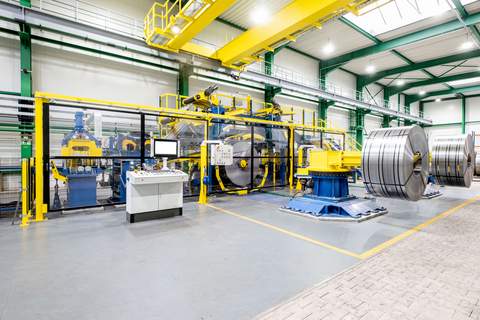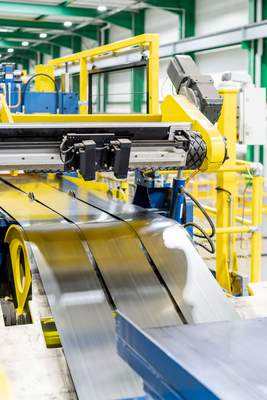KEY FACTS OF STRIP PROCESSING LINES
For precise strip processing, such as for annealing and degreasing, the critical design factors of steel industry strip processing lines are: strip drive speed, tension control and having a precise strip guide. At the same time customized cycle-times and storage specifications must be observed. Control of the cycle requires millimeter accuracy in the movement of the strip, with simultaneous precise regulation of the specified tension, without which strip quality would be impaired.
hpl-Group, based in northwest Germany, has specialized in the customized design of strip handling assemblies for more than 40 years, in cooperation with well known process part manufacturers, and OEMs. Lines have been designed incorporating design features unique to individual customer requirements, including for difficult to handle materials, such as high-alloy steels and stainless steels. hpl processing lines are capable of operating across a wide range of materials including: steel, stainless steel, copper, aluminum, coated metals and special materials, with strip widths ranging from 100mm to 1 750mm and strip thicknesses from 0.035mm to 7mm.
INITIAL DESIGN PHASE
The design process starts with an understanding of the available space, accepting that this may be quite limited due to the requirements of automation and the need to integrate with existing product flows. The first step is to map the overall site, using state-of-the-art 3D laser technology. These results provide the basis for the following planning and development phases. This detailed and sophisticated advance work is an essential part of creating a bespoke solution. Once the initial design is completed, based on a needs analysis, the project moves to manufacture and assembly. hpl are able to manage the entire project and beyond into maintenance if required.
hpl-GROUP STRIP PROCESSING LINES
As the cassette recorder requires a constant tape speed for playing good music, a constant strip speed is essential for getting the highest quality of processed steel strip (Figure 1). Any downtime in continuously running processing lines can lead to a high and expensive scrap rate. In addition to these requirements for optimal strip flow, the requirements for strip handling technology have changed a lot. Even though an operator, or the line supplier, may prefer to use the strip processing line for only a few strip qualities and grades, steel strip suppliers worldwide are currently faced with the challenge of processing a wide range of strip materials efficiently.
The motto ‘higher, faster, further’ seems to have developed in the direction of ‘thinner, faster, wider’ when considering today’s requirements for strip flow, where the highest priority is clearly placed on the gentle treatment of the surfaces and edges of the strip. Strip guide drive units face an ever greater challenge from the continuously increasing ratio of tension versus speed, generated by an increasing range of strip widths and thicknesses, as well as specific strip tensions. The drive and gear combinations used in strip processing lines with integrated strip tension measurements, are designed in such a way that the lines are able to meet the customer specification whilst requiring low energy consumption (Figure 2).
Energy efficiency and sustainability of drive technology is a high priority for customers engaged in strip processing. When operated in continuous, 24 hour mode, the main motors in the de-coiling and re-coiling area enable optimal utilization of input power. At temporarily higher speeds, such as during a coil change, or pick-up cycle, the motors are operated within the controlled overload range. In the interests of sustainability, heat recovery from the large drive packages can now be used to regulate the temperature of the operating establishment.
The pneumatic actuators and the consumption points of all assemblies, are integrated into the line design in such a way that compressed air, is reduced to a minimum. Hydraulics are required in approximately 90% of all strip processing lines, due to coil weights of up to 35t and the resistance of the strip itself (Figure 3). The hydraulics are also optimized for environmental sustainability, for example by means of frequency-controlled motor on the pumps. In addition to this requirement for management of cost and resources, a focus is maintained online performance. The strip processing lines, which together with the strip processing zone can extend to more than 100m in length, are supervised by a minimum number of operators.
During ‘normal operation’ without any coil changes, the operator can carry out all activities on the line in a pre-set time. Change-over times are limited by strip storage capacity, meaning that a smooth operation, with a high degree of automation, is required when changing coils, or sleeves in the de-coiling or re-coiling areas, as well as partially for feeding paper in the strip intermediate layers. This includes for example, sensor-assisted scanning of coil diameter in the area of the coil car, on which basis its precise position is calculated, thus ensuring an automated coil feed, or coil removal from the reel mandrels without any complications. The transition devices and strip forwarding units can be switched on and off using a sequential function chart programme, for guiding the strip to the strip connecting zone, for punching, or welding. This enables operators to take care of further handling steps synchronously. Cycle time studies can be prepared for this purpose.
Due to wide-ranging strip and line parameters, many strip processing lines require safety and quality-relevant accessories. These accessories include automatic cutting gap adjustments on the shears, air transfer tables for very thin foils with a thickness of for example 35 µm, strip centering systems for aligning the strip position, strip detection systems with brake and control units, or special devices facilitating the winding of initial wraps. In addition to the standard portfolio of assemblies, there is a focus on new and customized developments. Special concepts are currently being developed for incorporating lines into existing halls, in which no changes are to be made to the foundations. Here, the customer requirement has resulted in a solution, which does not require the classical coil cars. The coil handling function has been transferred to the de-coiler and re-coilers equipped with a coil lifting mechanism. An additional benefit was that the complete strip carry over system above the coiler was also no longer required and the strip could consequently run on an more streamlined line.
These creative and constructive ideas realized by the engineering team are also to be observed in the digital aspects of line operation. The strip processing lines are equipped with standard inspection systems, measuring the strip and winding quality, and with data acquisition systems that combine all integrated sensors, for example for speed, temperature, tension, length and vibrations, which are remotely transferred to a computer. Such collection and analysis of important data, creates transparency and a constant exchange between customers and the control technology partners, for continuous improvement and further development
SAFETY & CONTROL
The customized, turn-key solutions provided by hpl meet market requirements for the performance of parts and of line safety, relying on know-how concerning the development of sophisticated safety concepts, to ensure operator safety and high quality strip production. Safety is assured through risk assessment, an assessment of the performance level, integration with mechanical systems and connection to online control. Based on this theoretical input, state-of-the-art protective devices with integrated gates and light grids, are coordinated in such a way that that the continuous operation of the strip processing line is not interrupted at any time during the coil change in the de-coiling and re-coiling zone.
Dangerous tripping hazards are excluded at the outset, by means of underfloor coil cars equipped with automatically retractable anti-tipping devices, as well as floor-level, walkable pit covers. Safe entry to the line area is assured where required. Strip transfer units are designed in such a way that there is no need for manual intervention by an operator. Due to the extensive visualizations of the set and actual values of the most important line parameters, such as speed and strip tension, the operator has a comprehensive overview of the process parameters at all times and can intervene, if required, by triggering a safety shutdown at the push of a button.
Maintenance work can be carried out easily and quickly by the operator or the hpl service team using easily accessible maintenance points, whilst during service activities, the focus is always on ensuring that other lines in the factory continue producing without interruption in a safe working environment Longer, expensive production interruptions are therefore excluded right from the start.
CONCLUSION
The functional principle for strip processing is similar to that for tape cassettes, where only a sophisticated and precise strip flow leads to the best results, as specified by the user. However, whereas tape cassettes have been overtaken by digital media, steel strip will keep running into the future, with new trends integrated into processing lines. Forward looking processes, such as strip changes on the fly, or the processing of future oriented materials, such as aluminum and magnesium, will play an increasingly important role.
Customer requirements are always different, but with intensive design work, the desire for more efficient strip producing processes, of ever higher quality, can be met. The hpl-Group meets these requirements with an overall project concept that has broadened its horizon from being a strip handling expert to a genuine partner that keeps the strip process running and a clear focus on innovative ideas and know-how.

